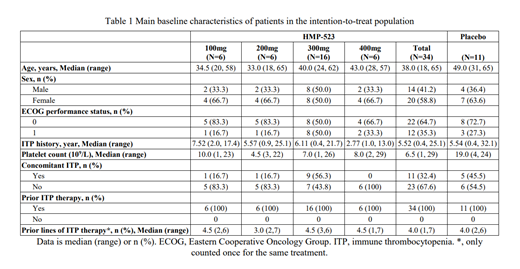Abstract
Background: Primary immune thrombocytopenia (ITP) is characterized by increased platelet destruction and impaired platelet production, resulting in decreased platelet counts and increased bleeding risk. Spleen Tyrosine Kinase (Syk) plays a pivotal role in the regulation of downstream signals in immune receptors, including B cell receptors (BCRs) and has been implicated in autoantibody production. On the other hand, all activating Fc receptors signal via Syk, which has roles in cellular proliferation, differentiation, survival, immune regulation, and cytoskeletal rearrangements during phagocytosis. This randomized, double-blind, placebo-controlled phase 1b study (NCT03951623) aimed to assess the safety, pharmacokinetics (PK), determine the recommended phase 2 dose (RP2D) and evaluate preliminary efficacy of HMPL-523, a novel, potent and highly selective Syk inhibitor, in patients with ITP.
Methods: Relapsed/refractory ITP patients with platelet counts less than 30×10 9/L were eligible for the study. This randomized study (3:1) consists of two stages with dose escalation (DES) and dose expansion (DEX). Four dose groups were set (100, 200, 300 and 400mg QD) and patients were randomized to either HMPL-523 or placebo in each dose group (n=8) to determine the RP2D in DES. Additional 12 patients were enrolled at RP2D to further assess the safety and efficacy in DEX. Each patient received an 8-week double blind treatment (8w-DB), followed by a 16-week, open-label HMPL-523 treatment (16w-OL), except for all patients of 100mg cohort and 2 patients of 200mg cohort (only received 8w-DB per protocol v1.0). Treatment-emergent adverse events were graded using the National Cancer Institute's Common Terminology Criteria for Adverse Events version 5.0. The efficacy of overall response rate was defined as the proportion of patients with at least one platelet counts ≥50×10 9/L, and durable response rate was defined as the proportion of patients with platelet counts ≥50×10 9/L for at least 4 of the last 6 scheduled visits.
Results: As of data cutoff (June 23, 2021), 33 patients (24:9) were enrolled in DES at 100-400mg. And 300mg QD was determined as RP2D. Additional 12 patients (10:2) were enrolled in DEX at 300mg QD. Main baseline patient characteristics are shown in Table 1. During 8-w DB treatment period, the overall response rate was 3 (50.0%), 2 (33.3%), 11 (68.8%) and 2 (33.3%) at 100-400mg dose cohorts, respectively, compared to 1 (9.1%) in the placebo. The durable response rate at 300mg was 5 (31.3%), compared to 1 (9.1%) in placebo. For all patients enrolled in 300mg cohort with at least one dose of HMPL-523 (n=20), including both 8w-DB and 16w-OL treatment period, the overall response rate was 80%; the durable response rate was 27.8% in the durable response-evaluable set (defined as patients received HMPL-523 treatment and completed at least 6 scheduled visits or discontinued during HMPL-523 treatment, n=18). No DLTs were observed at 100-400mg dose cohorts. The most common TEAEs (≥2 patients) related with HMPL-523 in 8w-DB were LDH increased (6 [17.6%]), ALT increased (5 [14.7%]), amylase increased (5 [14.7%]), AST increased (4 [11.8%]), neutrophil count decreased (3 [8.8%]), hypokalemia (3 [8.8%]), urine protein detection (3 [8.8%]), WBC count decreased (3 [8.8%]), gamma-glutamyl transferase (2 [5.9%]), asthenia (2 [5.9%]), dizziness (2 [5.9%]), total bile acid increased (2 [5.9%]), diarrhea (2 [5.9%]), abdominal pain (2 [5.9%]), hypertriglyceridemia (2 [5.9%]) and hyperlipidemia (2 [5.9%]). For all patients enrolled in 300mg cohort (n=20) throughout HMPL-523 treatment period (up to 24 weeks), ALT increased (5 [25.0%]), LDH increased (5 [25.0%]), AST increased (4 [20.0%]), total bile acid increased (4 [20.0%]), amylase increased (3 [15.0%]), TBiL increased (2 [10.0%]), hyperlipemia (2 [10.0%]) and hypertension (2 [10.0%]) were the most frequently reported HMPL-523-related TEAEs (≥2 patients). At the dose of 100-400mg QD, the exposure of HMPL-523 (C max and AUC tau) in plasma increased dose proportionally. Median T max was 4 h and mean T 1/2 was 11-13 h across all four dose levels.
Conclusion: HMPL-523 was well tolerated at all dose levels within the range of 100 mg to 400 mg. HMPL-523 300mg QD for ITP treatment is an efficacious and safe dose and recommended as RP2D. A randomized phase 3 study will commence to further confirm the efficacy of HMPL-523 in primary ITP.
Shi: HUTCHMED: Current Employment. Yin: HUTCHMED: Current Employment. Fan: Hutchmed: Current Employment.


This feature is available to Subscribers Only
Sign In or Create an Account Close Modal